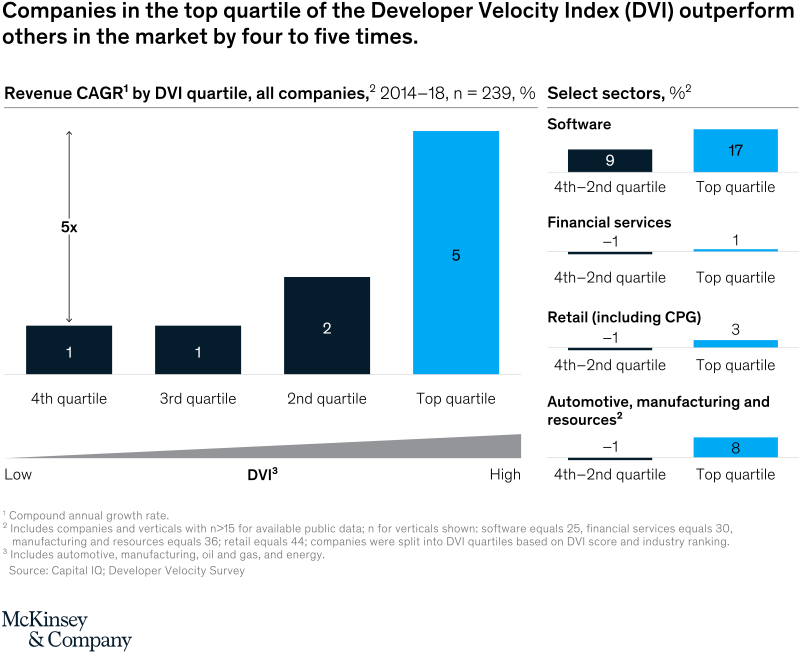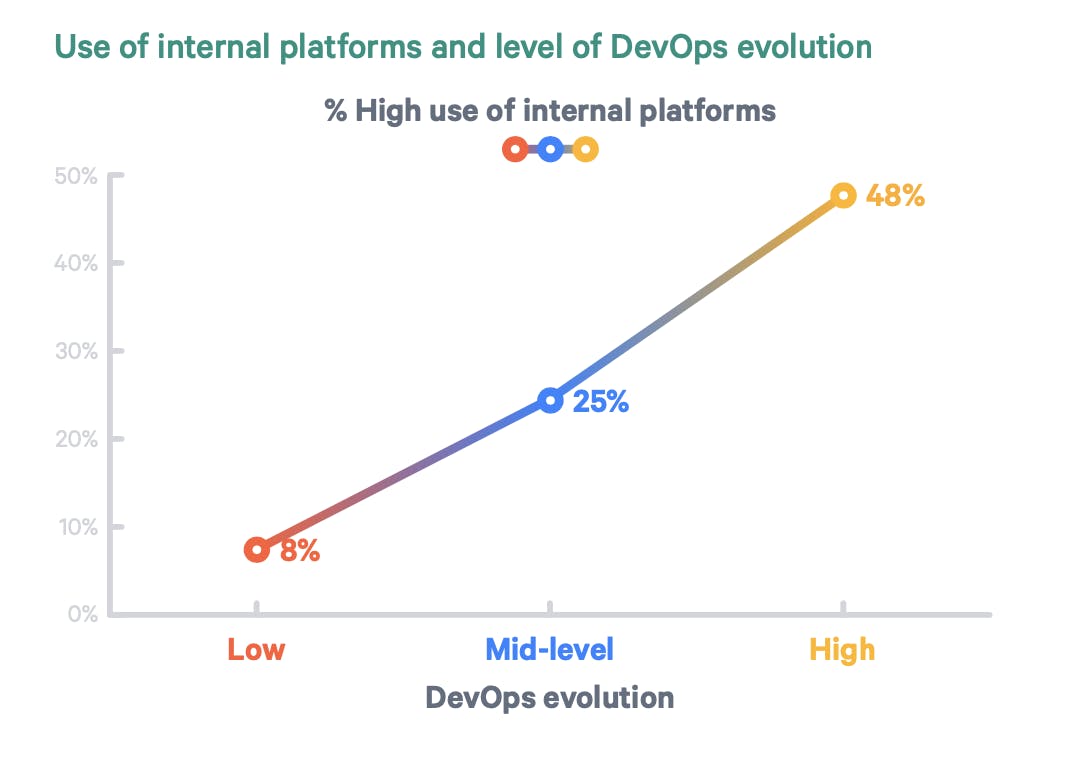Amplifying Developer Efficiency: Leveraging Internal Developer Platforms for Optimal Performance
Learn how developers can enhance their efficiency and streamline software development processes by integrating internal developer platforms into their daily workflow. This will set the stage for product successes that have never been seen before.

Morgan Perry
September 29, 2023 · 8 min read
It's not too much to say that today's developers often find themselves navigating the challenges of complex code, switching between software tools, and staying current with technical changes in the ever-changing world of software engineering. This highlights the need for internal development tools. Consider these platforms as fundamental pillars of the digital world. Internal Developer Platforms(‘IDPs) provide developers with a wealth of tools and resources to simplify their work. For a simple technical example, a programmer logs into an internal platform to acquire ready-to-use code snippets instead of writing them from scratch, which saves valuable time. This accelerates product development and ensures quality.
It is not just writing code faster, but the quality of the released product matters, too, perhaps the most. When engineers have the necessary tools, development speeds up, and products are more refined. By working together, teams can use their platforms to make a wide range of applications that are all precise. This shows how well engineering and platform management can work together.
#The Foundation of Developer Efficiency
#Linking developer efficiency to software product delivery
Developer efficiency is key to great software. The reasons are:
- Every software relies on its developers. More efficient engineers write better code, speeding up product delivery.
- The correct tools let developers quickly go from idea to code to product.
- DevOps approach connects development and operations, simplifying product releases.
#How streamlined development improves product quality
Here are the ways streamlined development results in better product quality:
- Streamlining development extends beyond speed. The article discusses code quality, which reduces errors and problems through efficient development processes.
- Simplified methods make product management proactive, improving quality.
- Software stability and performance improve when development and testing teams synchronize.
#The role of IDPs (Internal Development Platforms) in providing the necessary infrastructure for efficient development
Some core benefits of IDPs in development are:
- Platform engineering lets developers build, test, and deploy seamlessly in IDPs.
- These platforms give engineers the tools they need to work smoothly.
- IDPs enable teams to adapt and innovate by meeting various development needs.

#Internal Developer Platform (IDP) Explained
#Define Software Development IDPs and Core Objectives
Below are some of the core objectives of Software Development IDPs:
- An Internal Developer Platform (IDP) is a suite of tools that improves developer productivity and software development.
- The goal is to equip developers with tools and platforms for optimum code management and product development.
#Examining IDP Key Aspects and Functions
Below are some of the key aspects and functions of IDPs:
Aspects:
- Development Tools: These are essential for effective software development.
- Integration: Integration of development and operations significantly improves engineering processes.
- Code Management: Centralizes codebases for simpler editing.
- Functionality: IDPs facilitate software development by centralizing all tools. This streamlines engineering teamwork.
#How IDPs Serve Different Engineering Teams
Below are some ways IDPs serve different engineering teams:
- IDPs are adaptable to platform engineering, product development, and management developers' demands.
- Teams can customize platform tools to meet engineering needs.
- IDPs assist internal teams collaborate by providing uniform tools, and improving building efficiency.
#Advantages of Internal Development Platforms
#Accelerating Developer's Productivity
Below are some of the ways internal development platforms enhance programmer productivity:
- Internal platforms facilitate the software development process. Developers can devote more time to writing efficient code and less time to tedious manual duties. Take the example of a developer who previously spent hours cloning a microservices project with complex Kubernetes configuration. With an IDP that has environment-as-code capabilities, he can now spin up fully configured environments in a matter of minutes, minimizing the delay and errors.
- DevOps teams can provide developers with the appropriate tools. This expedites software development and reduces the time spent seeking external solutions.
#Improved Collaboration between cross-functional teams
Below are some of the benefits of fostering cooperation through internal development platforms:
- Engineering and product teams flourish when there's an open dialogue. This is fostered by internal platforms that ensure engineers and developers collaborate effectively.
- On these platforms, diverse teams, from management to developers, can align their objectives and develop collaborative solutions.
#Effective Resource Utilization
Here are some ways internal development platforms ensure effective resource administration:
- With platform engineering, resources such as cloud platforms are utilized judiciously to prevent waste.
- Such platforms facilitate consistent internal monitoring. This ensures optimal resource management and performance throughout all phases of development.
#Building Blocks of Internal Development Platforms
#Key Fundamentals of Effective IDPs
- Developer-Centric Approach: Developers require customized platforms. It fosters developer-friendliness.
- Engineering Mastery: IDPs are built on advanced techniques, and engineers play a key role in its design.
- Code Management: Effective code management streamlines software development and reduces bugs.
#Tools, Automation, and Cloud in IDP Architecture
Below are some of the key components of IDP architecture:
- DevOps tools: Tools power development. They make product development and management easy for developers.
- Automation: Platform engineering requires automation. It speeds development and reduces errors.
- Cloud services: Cloud services are scalable and flexible. They ensure product versatility and meet varied needs.
#IDP Adaptability and Scalability
The beauty of IDPs is their capacity to adapt to needs. Teams can quickly adapt to shifting demands with a strong internal foundation.
Scalability is crucial as software and development landscapes evolve. An effective IDP should develop with its teams, encouraging innovation and building.
#Customizing Your IDP for Success
#Tailoring IDPs to Unique Needs
Below are some of the ways to tailor your IDPs:
- Customization: Tailor your Internal Development Platforms (IDP) to align with the unique needs of developers. No one-size-fits-all approach here!
- Support Different Tools: DevOps teams often use varied tools. An efficient IDP should be flexible enough to integrate these different tools, enhancing product development.
#The IDP Trifecta: Security, Scalability, Flexibility
Some key pillars of an effective IDP are:
- Security: Developers should never compromise here. Internal platforms must have layers of security to ensure code safety.
- Scalability: As teams grow and products evolve, the platform should too. Ensure your IDP can handle the burstiness of increased engineering demands.
- Flexibility: The beauty of software development lies in its fluidity. Platform engineering should allow for pivots, quick changes, and adaptability.
#Implementation Strategies for Internal Development Platforms
#Synergy of DevOps and IDPs
- DevOps already joins development and operations for quick product rollout. Adding IDPs can take this to the next level.
- IDPs serve as an essential toolkit for developers. They offer specialized tools tailored to software engineering needs, making the development process smoother.
- Take the example of a developer named Alex. Alex needs to clone a complex environment for a client demo, replicating live data. In traditional settings, this task would require tedious coordination and might take hours or even days. However, with an IDP equipped with a self-service portal, the process is revolutionized. Alex can effortlessly set up the environment through the self-service portal and in a fraction of the time, have everything ready for the demo. This highlights the efficiency and agility that an integrated IDP brings to the table.
#Real-World Integration of IDPs
Many engineering teams already champion the merits of IDPs. Their real-world application reveals a pattern such as:
- Efficient Management: IDPs help teams organize their work, from code management to software building.
- Diverse Tools: IDPs provide a comprehensive set of tools, ensuring every engineer finds the right fit for their project.
- Platform Engineering: An IDP fosters a symbiotic relationship with platform engineering, enabling developers to build better and more robust products.
#Tackling Common Challenges in IDP Implementation
#Recognizing and Addressing Common Obstacles
Below are some of the challenges faced during IDP implementation:
- Platform Integration: Integrating many software tools into one internal development platform is difficult for developers.
- Code Management: Engineers must manage code variants and integrations without disturbances.
- Alignment: DevOps and developers must work together to optimize building.
#Solutions to these Challenges
Below, we have compiled some solutions to combat the above challenges:
- Unified Tools: Choose systems that integrate development tools smoothly.
- Strong Code Management: Use software for code merging and version control.
- Training: Give engineers and developers regular training on the changing platform engineering landscape.
#Successful IDP Implementation Case Studies
A renowned product management organization had an internal disconnection between their developers and DevOps teams. They implemented an IDP which streamlined their operations by:
- Creating an internal platform tailored to their needs.
- Integrating tools for smoother coordination between development and operations
- Frequent feedback loops to help teams improve their processes.
#Key Benefits of IDPs
#Measurable outcomes and performance metrics achieved through IDP adoption
- Increased Productivity: Internal Development Platforms make coding easier for developers. By centralizing tools, developers spend less time switching applications.
- Consistent Development: Engineering teams reduce errors through consistent development processes. For instance, using one platform for code management and another for DevOps becomes simpler when integrated under an IDP.
- Better DevOps Management: IDPs streamline DevOps processes. Unified technologies facilitate building and launching products.
#Valuable insights and lessons learned from successful IDP implementations
- Customization matters: No one size fits everyone. Developer needs vary; hence, the platform should be flexible.
- Internal Collaboration: Teamwork platforms produce solid products. This stresses collaborative product creation.
- Focus on Continuous Learning: IDP successes provide insights. A technical team may discover a tool that improves efficiency. Sharing findings boosts growth.

#Conclusion
Issues can hinder software engineers in this era of rapidly evolving technology. This article discussed how Internal Development Platforms (IDPs) can improve development and address these issues. IDP engineering improves developer productivity, workflows, and collaboration. A developer can customize an IDP for a small or large tech team.
Combining DevOps and IDP could revolutionize software engineering. Engineers, platform specialists, and product teams are excited about the current state of development. Internal development platforms help developers and engineers create software masterpieces quickly and accurately.
IDPs are important in software development, and the article explains their benefits. IDPs inspire developers, coders, and product innovators. Developers and engineers should embrace these platforms, collaborate with internal teams, and imagine a future where software creation goes beyond coding.
Your Favorite DevOps Automation Platform
Qovery is a DevOps Automation Platform Helping 200+ Organizations To Ship Faster and Eliminate DevOps Hiring Needs
Try it out now!

Your Favorite DevOps Automation Platform
Qovery is a DevOps Automation Platform Helping 200+ Organizations To Ship Faster and Eliminate DevOps Hiring Needs
Try it out now!

